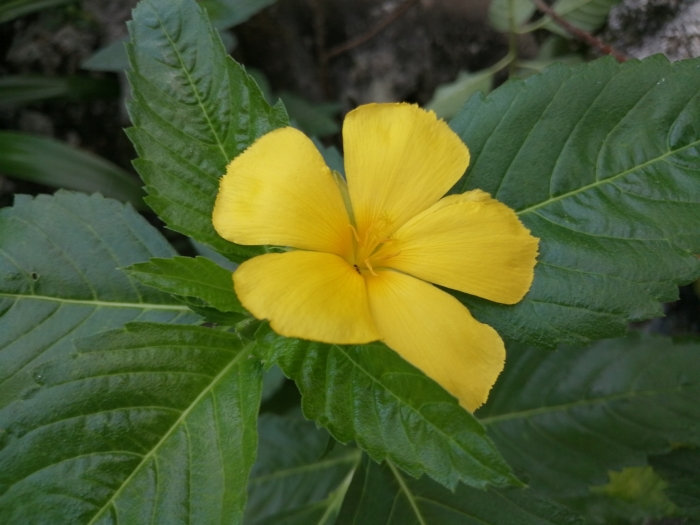Ramgoat Dashalong
(Turnera ulmifolia)
Ramgoat Dashalong (Turnera ulmifolia)
/
/

五色鳥
CC BY 4.0
Image By:
五色鳥
Recorded By:
Copyright:
CC BY 4.0
Copyright Notice:
Photo by: 五色鳥 | License Type: CC BY 4.0 | License URL: http://creativecommons.org/licenses/by/4.0/ | Rights Holder: 五色鳥 | Publisher: iNaturalist | Date Created: 2021-10-10T07:55:08-07:00 |

























Estimated Native Range
Summary
Turnera ulmifolia, commonly known as ramgoat dashalong or yellow alder, is a perennial herb native to tropical forests and scrublands of Mexico, the Caribbean, and the West Indies. It typically grows to a height of 2-3 feet (0.6-0.9 meters) and is characterized by its erect form, dark green, toothed leaves, and small yellow-orange flowers. The flowers are particularly notable for their daily blooming pattern, opening around 6:00 a.m. and closing by 11:30 a.m., each lasting approximately six hours. Flowering occurs throughout the year in its native habitat, providing a long-lasting display of color.
Yellow alder is valued for its drought tolerance and adaptability to poor soils, often found growing on walls, cement blocks, and rocks, making it a versatile plant for challenging garden spots. It is also appreciated for its attractiveness to butterflies, especially as a food source for the larvae of the Tawny Coster butterfly. In cultivation, it requires minimal water and thrives in full sun to partial shade, preferring well-drained soils. While it is not commonly used for culinary or medicinal purposes, its ornamental appeal makes it suitable for border planting, container gardening, and as a ground cover in tropical and subtropical gardens. Gardeners should be aware that Turnera ulmifolia can become invasive outside its native range, so it is important to check local regulations before planting.CC BY-SA 4.0
Yellow alder is valued for its drought tolerance and adaptability to poor soils, often found growing on walls, cement blocks, and rocks, making it a versatile plant for challenging garden spots. It is also appreciated for its attractiveness to butterflies, especially as a food source for the larvae of the Tawny Coster butterfly. In cultivation, it requires minimal water and thrives in full sun to partial shade, preferring well-drained soils. While it is not commonly used for culinary or medicinal purposes, its ornamental appeal makes it suitable for border planting, container gardening, and as a ground cover in tropical and subtropical gardens. Gardeners should be aware that Turnera ulmifolia can become invasive outside its native range, so it is important to check local regulations before planting.CC BY-SA 4.0
Plant Description
- Plant Type: Shrub, Herb
- Height: 0.5-1 feet
- Width: 0.5-1 feet
- Growth Rate: Rapid
- Flower Color: Yellow
- Flowering Season: Spring, Summer, Fall
- Leaf Retention: Evergreen
Growth Requirements
- Sun: Full Sun
- Water: Medium
- Drainage: Medium
Common Uses
Border Plant, Butterfly Garden, Groundcover, Low Maintenance, Potted Plant, Showy Flowers, Street Planting
Natural Habitat
native to tropical forests and scrublands of Mexico, the Caribbean, and the West Indies
Other Names
Common Names: Yellow Alder, Sage Rose, Du Thym, Lalo, Mari Lopez (Puerto Rico), Mari-Lope, Marilop, Yellow Buttercups
Scientific Names: , Turnera ulmifolia, Piriqueta ulmifolia, Turnera alba, Turnera angustifolia, Turnera chamaedrys, Turnera cistoides, Turnera corchoroides, Turnera cuneiformis, Turnera frutescens
GBIF Accepted Name: